Raised Heels Squatting vs. Flat Heels Squatting
Author:
Unlock your full potential by engaging with our experts and community! Have questions about your fitness journey or looking for expert advice on weightlifting techniques? Don’t hesitate — leave a comment below and Oleksiy Torokhtiy will provide a personalized answer and insights to help you reach your goals.
Torokhtiy is reader-supported. Some links are affiliate links, and we may earn a commission at no extra cost to you. See our disclosure page for details.
Maintaining a proper squat form is vital for all lifters; however, doing so is easier said than done. When you step into the gym, you will see two common variations – raised heels squatting and flat heels squatting, and today we will be discussing both of them. We will talk about the differences between each variation, what kind of shoes are needed for the different types of squats and why they matter so much for proper form.
The difference between raised heel squatting and flat heel squatting comes from the type of shoe that’s being used. For some squat variations, raised heel shoes are better as they help the athlete maintain proper form, while in other cases, flat shoes for squats are the better option.
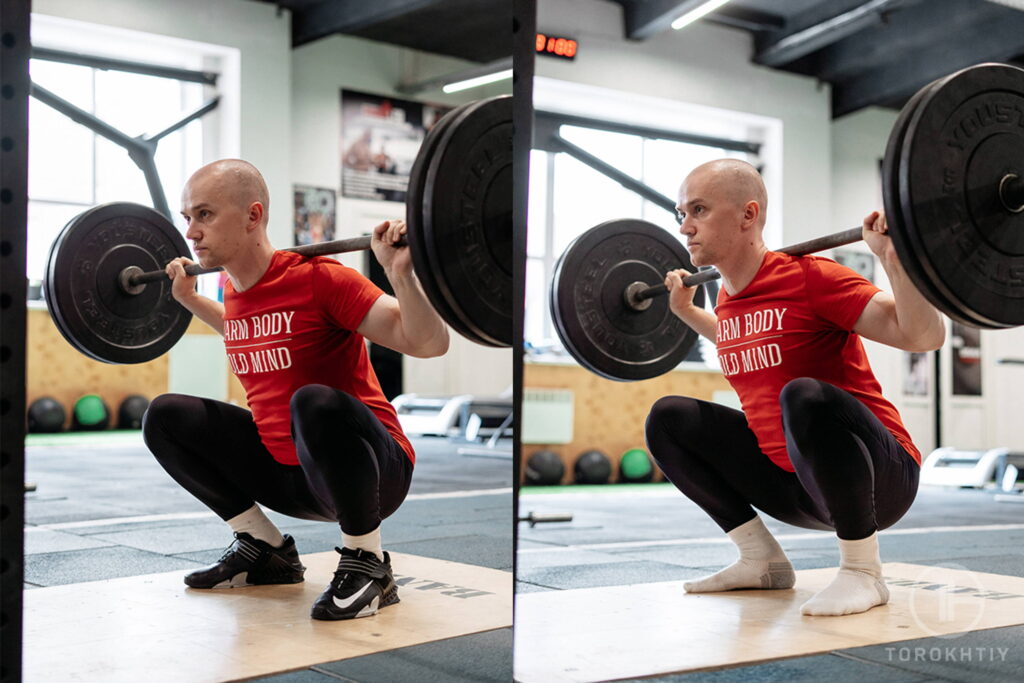
What is the difference between heeled and flat shoes?
Before we start discussing what kind of shoe is better for squats, let’s first take a deep dive into the difference between these two types of shoes.
When we talk about flat-heeled shoes, we mean all types of shoes that have a 0mm heel-to-toe drop. This means that when you take a look at the shoe, there’s absolutely no difference between the height of the forefoot and the height of the heel. Essentially, when you put these kinds of shoes on, your feet will stay completely flat on the ground with zero elevation. On the other hand, elevated heel shoes are those that have a heel that extends past what’s considered a normal heel-to-drop height for shoes. Typically, standard training shoes have a heel-to-drop range between 0mm – 8mm (0.0” to 0.3”). In contrast, heel-elevated shoes range from 0.6” to 1”. By wearing this kind of shoe, a lifter can get a 15mm-25mm (0.6” – 1”) heel-to-toe-drop difference, which is vastly different when compared to the typical 0mm – 8mm (0.0” to 0.3”) range that most shoes have.
In order to make the difference even more clear, let’s take a look at a few examples of flat shoes and of elevated heel ones. Popular flat shoes include Vans and Converse sneakers, as well as barefoot shoes. At the same time, elevated heel shoes are the ones made for professional weightlifters, such as the Reebok Legacy Lifter or Nike Savaleos. However, that still doesn’t give an answer to the question of which ones you should use during your training.
Things To Consider When Choosing Between Heeled And Flat Shoes For Squats
When you put on a pair of elevated heel shoes, you will quickly notice how the entire position of your body changes. Of course, this also means that your form will alter once you start to squat in them. When doing elevated heel squats, thanks to the shoes, your foot will be put into a plantarflexed position, which promotes more knee tracking, gives your ankles more range of motion, and helps you keep your torso upright while going through the movement. Essentially, elevated heel shoes help you maintain proper squat form, making it easier to achieve squat depth and maintain your balance, even when performing the exercise with heavy weights. This type of footwear is especially helpful for athletes that lack or have limited mobility in the torso, hip and ankle as they make the proper form easier to maintain.
On the other hand, when it comes to flat shoes, things are a lot easier to understand. Essentially, they give you the opportunity to squat as though you’re going barefoot. If you have good mobility and are able to maintain proper squat form easily, then you will likely enjoy lifting in these shoes as they give you better balance and more stability.
Okay, now that you know what each of these shoes helps promote, let’s take a look at three things you need to consider before choosing the right squat shoe for you.
Your Ankle Mobility
The first and most important thing to consider is your ankle mobility or lack of such. You have to remember, if we all had terrific ankle mobility, there would be no need for elevated-heel shoes. As I already mentioned above, elevated-heel shoes ensure greater degrees of ankle flexion, which in turn gives the lifter a wider range of motion in the squat. It’s up to you to determine whether you lack ankle mobility because of tissue or structural restrictions.
If the limited range of motion in the ankle is due to a structural restriction, that means that you physically cannot dorsiflex your ankle any further. That might be due to your natural build or a result of an injury you sustained that later led to structural limitation. In such cases, using an elevated-heel shoe is the only option for squatting.
On the other hand, if the issue is tissue-related, then you can work on your ankle mobility and get better over time. However, still heeled shoes remain a good option as using them is a quicker solution in comparison to doing mobility work, which will take at least a few weeks or months to give results.
Your Height
Generally, the taller you are, the more you will benefit from doing a heel-lifted squat in proper shoes. That being said, when it comes to the biomechanics of the squat, what matter is the relation of your different body part lengths compared to each other, rather than how tall you are.
However, in most cases, people that are really tall typically have long legs (longer than their torso), which means they also need more ankle flexion compared to other lifters. Just consider this: a tall person with long femurs and a short torso typically has to travel more distance in a squat than someone with shorter legs and a longer upper body. And the longer the distance, the harder it becomes to maintain proper form throughout the entire movement. That is why, for taller lifters using heel-elevated shoes is definitely recommended, even if they have adequate ankle mobility.
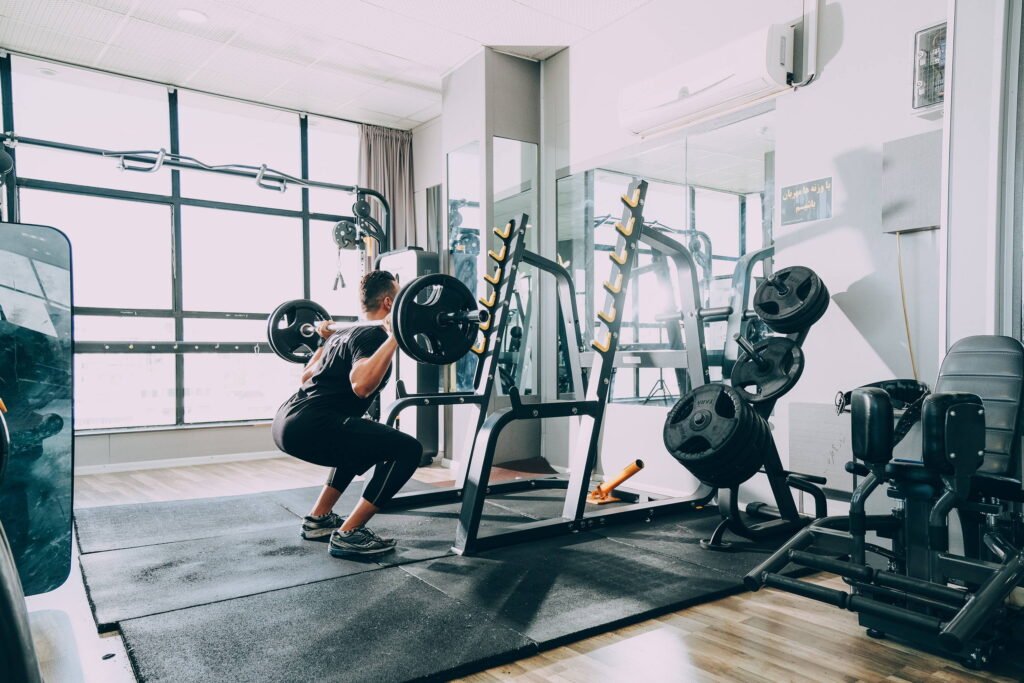
The Type of Squat You Most Often Do
We won’t go into the entire – low or high bar squat debate; however, we will talk about what kind of shoes are better suited for each of these variations.
Typically, low bar squats are preffered by powerlifters, and they’re the variation that can be done with either flat or heel-elevated shoes depending on the other factors we already discussed above. This means that if you have good squat form and no mobility issues, you can safely perform low bar squats with flat shoes.
Having said that, high bar squatters will see a lot more benefits from using heel-elevated shoes. That’s because, in this variation of the squat, the torso has to remain more upright, and it’s also a knee flexion dominant squat, which requires more ankle flexion as the knee has to extend further forward. So, if you prefer doing the high bar variation, you will definitely benefit from doing a heel-lifted squat with professional weightlifting shoes.
Heeled shoes – Pros & Cons
We have already discussed what kind of things you need to consider before choosing what type of shoe to squat in. Now, let’s take a more in-depth look into the benefits and downsides of using elevated-heel shoes, as well as what kind of athlete they’re most suitable for.
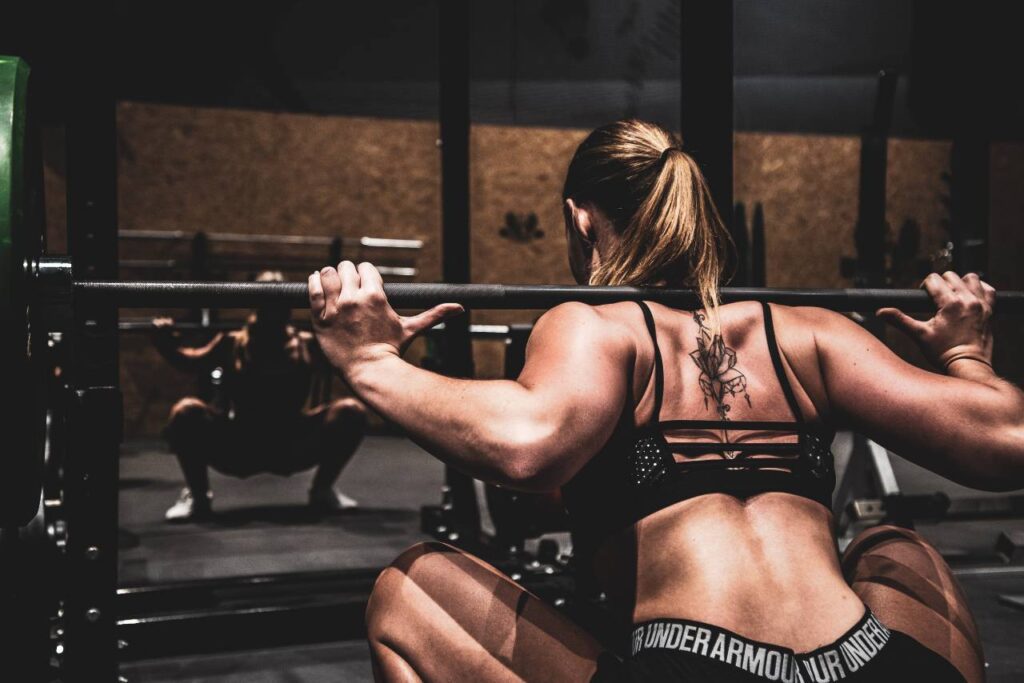
Pros:
- They help you get a better range of motion when performing squats.
- Give more stability and protect the foot when doing heavy lifts.
- Help you maintain proper form throughout the entire movement.
Cons:
- Have benefits only when performing particular exercises
- Can be quite expensive
Generally speaking, weightlifting or heel-elevated shoes are a must-have for any professional or semi-professional weightlifting athlete, regardless of whether you’re doing powerlifting, Olympic weightlifting, or even fitness. They will help you maintain proper form, even when squatting with heavy weight, which is essential for lifters who constantly want to improve their results and performance.
Best Heeled Lifting Shoes We Recommend
UPDATE! Here’s a new model – Reebok Legacy Lifter III that can become a true discovery for those who are fans of the Legacy Lifter model, or their Lifters II are already out.
Despite the model has lots in common with the Legacy Lifter II, it has a novelty – the pump technology which can be useful for enlarging the volume of the tongue. This feature can benefit athletes with narrow feet by bringing better support and security, so the shoes hug the feet wholly.
When it comes to lifting shoes, you can’t go wrong with the classic Reebok Legacy Lifters II. They’re a solid, proven shoe that has been used by many professional lifters for years now. The Legacy Lifters have a textile upper with breathable mesh, which makes them comfortable to wear and less sweaty. Along with that, the TPU heel clip and the rubber outsole provide even more stability and ensure that you will remain firmly on the ground and balanced, even when doing your one-rep max squat. Finally, Reebok makes these shoes in various colorways and for both men and women, meaning they’re a suitable choice for all lifters.
Flat shoes – Pros & Cons
Most casual lifters and gym go-ers typically wear this type of shoes, so you’ve likely seen more than one pair of Vans or Converse sneakers when doing your training session. However, using this kind of footwear comes with its pros and cons, so let’s take a look at them.
Pros:
- A great option for casual lifters or beginners who have good squat form and don’t lack ankle mobility
- Provide stability and are a solid option for moderately heavy lifts
- They can be easily found and are relatively cheap compared to elevated heel shoes
Cons:
- Using them can lead to bad form if the lifter lacks ankle mobility
- Don’t give any lifting benefits to the athlete using them
Using flat shoes for squats is a good option for people that only casually train or for athletes that have only one or two weightlifting sessions per week, and their training focus is set on other goals. They’re a relatively cheap option that can be used for a variety of purposes, so having a pair in your closet is always a good idea.
Follow us!

Free!
Get a 2-week Weightlifting Program as a bonus for the subscription to kickstart your training plan!

Free!
Best Flat Lifting Shoes We Recommend
We won’t be recommending the typical Vans or Converses in this article. Instead, we will give you a great but unpopular option – Sabo Deadlift shoes. Now, we don’t want to start a deadlift shoes vs. squat shoes debate. We’re simply recommending this pair because it’s a solid flat shoe that can also be used for other training purposes. Thanks to their high build, they provide stability and comfort while keeping the ankles safe and tight. The Sabo Deadlift shoes are also a terrific option for those of you who want to compete in any kind of weightlifting competition, as this is also another professional weightlifting shoe.
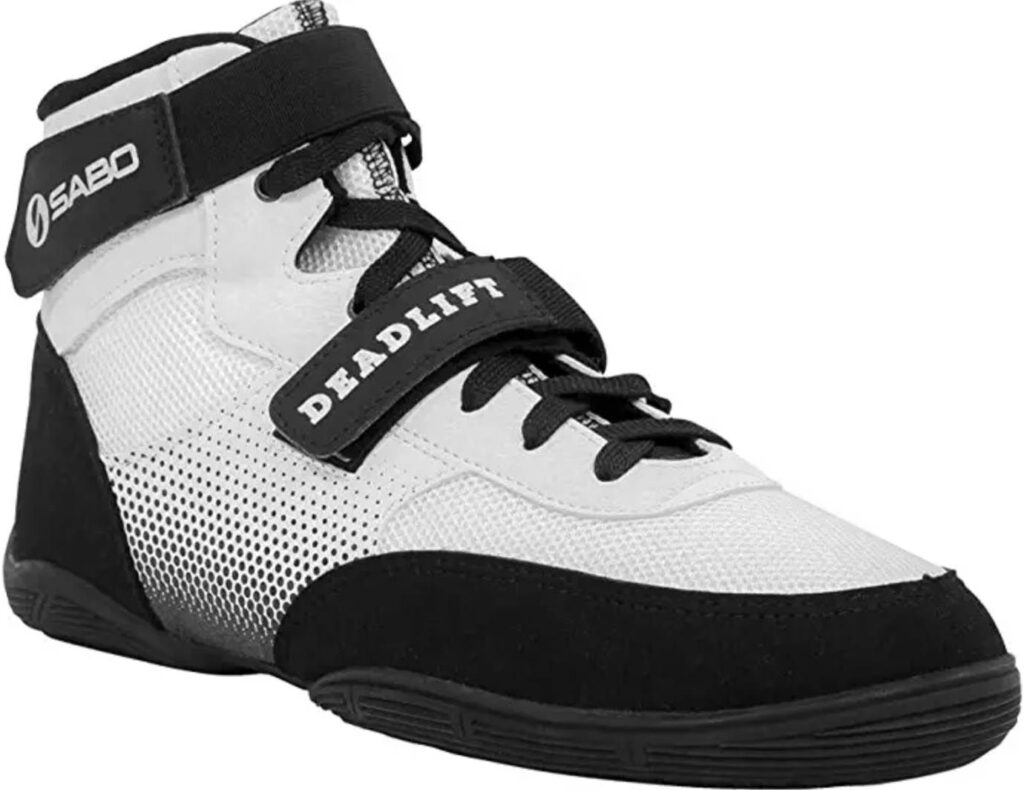
F.A.Q.
Why is it easier to squat with heels elevated?
The elevated-heel position allows you to keep your torso upright and helps you need less mobility in the ankles, making the squat movement easier and giving you a great range of motion.
Is it OK to squat with plates under heels?
Yes, however, you need to be careful when performing squats with plates under the heels. If you’re planning on doing heavy squats, the better option is to use elevated-heel shoes, as squatting with plates under your heels can be dangerous and lead to potential injuries.
Are wrestling shoes good to squat in?
Yes. This is essentially the same as comparing professional weightlifting squat shoes vs. flats. Wrestling shoes are a variation of the flat shoe that’s typically preferred by powerlifters as they are also suitable for other exercises like the deadlift.
In Conclusion
Wearing flat shoes for squats is a solid option for those of you who aren’t professional lifters and aren’t looking to massively improve your results and set PRs. However, for anyone that wants to compete in powerlifting or Olympic weightlifting, elevated-heel shoes are a must, as they help you improve your squat training sessions and ensure you’re always squatting in proper form, regardless of how much weight you’ve put on the bar.
Now, have any of you worn heel-elevated shoes for your squat sessions? If yes, then what’s your opinion? Let’s hear it down in the comments section.
Also read:
- Are Nike Blazers Good for Lifting
- Are Basketball Shoes Good for Lifting
- Squatting Barefoot vs Shoes
- Are Converse Good For Lifting
- Deadlift Shoes Guide
References:
- Exactly How to Do Squats, Including Common Mistakes and Variations // Runner`s World:
https://www.runnersworld.com/training/a32256640/how-to-do-a-squat/ - How To Improve Ankle Mobility // TWL:
https://blog.thewodlife.com.au/how-to-improve-ankle-mobility/ - 7 Mobility Exercises to Boost Your Health and Fitness // EveryDayHealth:
https://www.everydayhealth.com/fitness/mobility-exercises-to-boost-your-health-and-fitness/
Why Trust Us?
With over 20 years in Olympic weightlifting, strength training, nutrition coaching, and general fitness our team does its best to provide the audience with ultimate support and meet the needs and requirements of advanced athletes and professional lifters, as well as people who strive to open new opportunities and develop their physical capabilities with us.
By trusting the recommendations of our certified experts in coaching, nutrition, and sports training programming, as well as scientific consultants, and physiotherapists, we provide you with thorough, well-considered, and scientifically proven content. All the information given in the articles concerning workout programming, separate exercises, and athletic performance, in general, is based on verified data.
The product testing process is described in more detail here.
Author: Oleksiy Torokhtiy
Olympic Weightlifting Champion
Best Results: Snatch – 200 kg,
C&J – 240 kg
Oleksiy Torokhtiy is a professional athlete boasting 20 years of experience in Olympic weightlifting. With multiple European and World titles under his belt, he has showcased his prowess in two Olympic Games (Beijing 2008 and London 2012). Upon concluding his illustrious career, Oleksiy dedicated himself to coaching. By 2022, he had conducted over 200 weightlifting seminars worldwide. He is the visionary behind an international sportswear and accessories brand known for its motto, “Warm Body Cold Mind.” Additionally, he is an esteemed author and the creator of a series of training programs and eBooks.




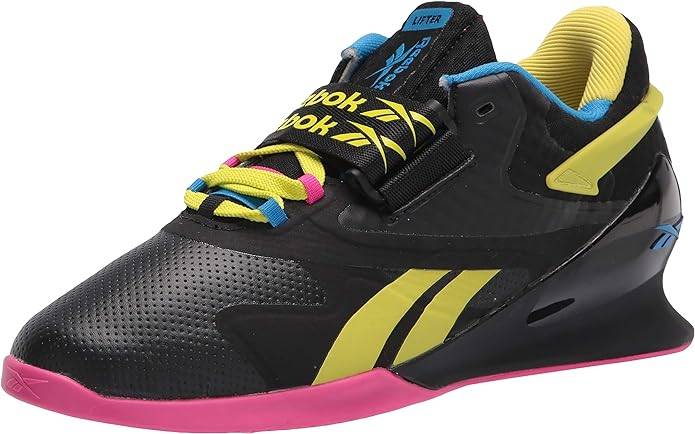
Still have questions after reading our article? Unlock your full potential by engaging with our experts and community! Don’t hesitate — leave a comment below and Oleksiy Torokhtiy will provide a personalized answer and insights to help you reach your goals.